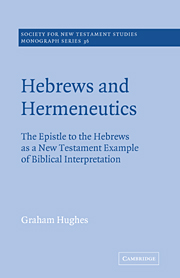 Hebrews and Hermeneutics
Hebrews and Hermeneutics Summary
The inclination to introduce any study on the Epistle to the Hebrews by remarking in some way or another on the enigma which attends this important letter of our New Testament canon seems almost irresistible. The tendency is not difficult to account for. On one hand the letter's significance as an early source for, and continuing influence upon, the devotional piety and understanding of Christians is unquestionable. Attention is frequently drawn, for instance, to its important statements about the nature of worship. It is the source of profoundly important Christian conceptions such as the highpriesthood of Christ, or of Christian life as an ongoing pilgrimage. Over many centuries Christian theologians have allowed themselves to be guided in Christological explorations by the heavy emphases the letter places on both the humanity of Jesus and also his dignity as Son of God. Some passages, for example the ‘definition of faith’ at the head of chapter 11 or the carefully written opening statement about the Word of God which culminates in Jesus the Son, have regularly served as models for the expression of these ideas.
But on the whole these contributions made by the unknown author of our letter function in isolation from their context. As a document, the letter attracts only minimal attention either from scholars, or from those who read for more devotional or homiletical purposes.
- Type
- Chapter
- Information
- Hebrews and HermeneuticsThe Epistle to the Hebrews as a New Testament Example of Biblical Interpretation, pp. 1 - 4Publisher: Cambridge University PressPrint publication year: 1980
